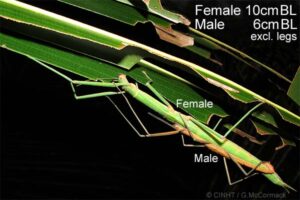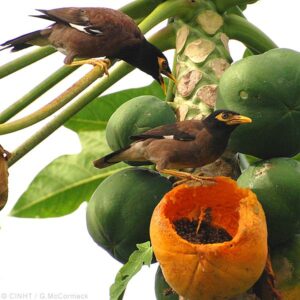Gerald McCormack, CINHT
The myna is locally much loathed as a pest, yet it arrived in the early 1900s with such high hopes as the “farmer’s friend”. We follow its triumphant march from India to many countries, including the Cook Islands.
The “farmer’s friend”
The Common Myna is indigenous to southern Asia, primarily India. It lives in open woodlands but is strongly associated with people in agricultural and urban areas. It is known as the “farmer’s friend” because it helps control insects.
It was probably the first animal introduced to another country as a biocontrol, when the French took some from southeast India to Mauritius and Réunion islands in 1763 to control locusts/grasshoppers in the sugarcane fields. The French colonists called them “Martin” after Captain Martin of the ship “Gracieuse” that had brought them. The locusts were soon much reduced and the Martin was given the credit.
A little later, in 1766 Linnaeus considered this bird to be a bird of paradise and named it Paradisea tristis, meaning the dull bird of paradise. In 1816 Vieillot made the genus Acridotheres meaning grasshopper-hunter,and our myna became Acridotheres tristis; literally meaning the dull grasshopper-hunter. An obvious misnomer for a bird that is not dull in behaviour or appearance.
These birds and their relatives are Asian starlings and they are known in Hindi as Mainā, meaning “delightful”, referring to their varied calls and speech mimicry. Mainā is rendered into English as mynah or myna, while the French name is martin. Our particular myna is the Common Myna or Indian Myna, and it is identified in French as Martin triste.
Introductions continued
A hundred years later the myna became very popular and it was introduced in 1862 to Melbourne for no known reason, and thence to Queensland in 1883 to control Plague Locusts and insects in sugarcane. In the Pacific they were first introduced to Hawai‘i (1865 from India for insect control in sugarcane), then New Caledonia (1867 from Réunion for locusts and insects in sugarcane), New Zealand (1870 from Melbourne to enhance the fauna), Fiji (c.1890 or earlier for insects in sugarcane), and Tahiti (unknown date but pre-1904 for paper wasps and cattle ticks).
Cook Islands introductions
Visiting Rarotonga in 1904, Clement Wragge wrote that “Bird life was most meagre, and this was especially striking on our drive around the island” and therefore insect pests were abundant. He wrote that on other Pacific islands the “mina” had been introduced to control insects with happy results, but that here the Resident Commissioner feared “to try the experiment, lest the birds should destroy the fruit.” Wragge’s round-island guide told him that “If insect-eating birds are not soon introduced, the pests will ruin us.”
Two years later, in March 1906, Sidney Davis, the manager of Cook Islands Trading Company, wrote to his trading partner in Tahiti, Mr. H. Meuel, to obtain some “Indian Minahs”. Mr Meuel replied that he knew of them as the Merle des Moluques (“thrush of the Moluccas”) and could obtain them at about 4 shillings a pair (about $30 today). He noted that they had been “imported to help in the destruction of wasps, but it was found in practice that they also fed with preference on native fruit, such as Bananas, they multiply pretty fast…..”.
The first colony of about 20 birds arrived in late June. They were released on the Davis farm in Tītīkāveka and were known as Manu Tēve, Davis’s Bird. On the 12th of July Gudgeon showed Government support by protecting the “Minahs imported from Tahiti” which “are likely to benefit the island by keeping the insect pests in check.” Any conviction for shooting or injuring the birds carried a fine of £5 (about $700 today).
The Cook Islands Trading Company (CITC) imported more mynas in 1907 and 1909 and also around this time Jean Peyroux brought mynas from Tahiti to Matavera where they were known as Manu Piru – Peyroux’s bird.
At the time of these introductions there is no known mention of a particular insect to be controlled. It was not until January 1914 that the Fruit Inspector, Mr E.A. Reid, reported that the mynas were increasing rapidly and “were putting a severe check on the stick insect which attacks the leaves of the coconut palms.” And in 1933 biologist Whitley was told that mynas had been introduced to “cope with the large introduced wasps” [Paper-wasps, Rango Patia, Polistes spp.].
Coconut Stick-insect

The humongous female Coconut Stick insect munches a coconut leaflet while the puny male starves to perform his duty.
The Coconut Stick-insect (‘Ē, Graeffea crouanii) was an accidental introduction of the ancient Polynesians. In the 1800s the missionaries and other visitors reported that these insects were often in plague proportions and could rapidly destroy coconut plantations. People often made smoky fires in a usually futile attempt to control the insect.
In April 1915 Brian Morris, the Resident Agent of Ma‘uke wrote to the administration on Rarotonga requesting that mynas be sent because he feared that a plague of Coconut Stick-insects might destroy all their coconut palms. The Government arranged for mynas to be sent from Tahiti to Mangaia and Aitutaki in 1915 and to Ma‘uke and Ātiu in 1916.
Mr. Russell was the Resident Agent on Ātiu at that time and mynas were initially called Manu Rataro, Russell’s bird. In time the national name standardised to Manu Kavamani, Government Bird. The initial Mangaia colony failed and the Ministry of Agriculture successfully introduced mynas from Rarotonga in 1958 to help the depressed copra production.
Number 1 alien invasive bird

The winners of a territorial dispute immobilise a challenger while its partner looks on in dismay. Such battles are highly ritualised and, despite their intensity, the combatants are rarely injured.
In 2000 the International Union for the Conservation of Nature (IUCN) declared the Common Myna the number 1 invasive alien bird in the world, and the third most invasive alien species behind the Australian Black Wattle and the Giant African Snail. In Australia in 2004 the Myna was voted the number 1 pest in a national-wide survey by the Australian Broadcasting Association, ahead of the ecologically devastating Cane Toad.
In the Cook Islands the myna is the most abundant bird on Rarotonga, Aitutaki, Ātiu, Ma‘uke and Mangaia – it was not introduced to Miti‘āro and it has not invaded from the neighbouring islands.
Although mynas are known to eat many insects they are widely disliked because they harass nesting native birds, attack fruits the day before people pick them, steal food from within houses, make a very loud noise at dusk in roosts, mob and embarrass cats in their own homes, and build untidy nests in holes in houses – and, their rowdiness and territorial aggression are embarrassing reminders of ourselves. Many people kill mynas on their properties and most people wish the myna had not been introduced or would now disappear.
The Ātiu eradication project
In the last 25 years many communities around the world have started attacking mynas to reduce their numbers or eradicate them. In Canberra alone more than 30,000 mynas had been trapped by the end of 2010 and Fregate Island (220ha) in the Seychelles established a record by eradicating a thousand mynas in 2010.
In May 2009 the Natural Heritage Trust started a project with the Island Council to reduce their mynas and this became an eradication project in November 2010. The 3-pronged attack of poisoning, community trapping and shooting, and non-resident shooters has been very successful and we estimate there are now less than a thousand to go – the most difficult thousand!
If successful, this eradication will eclipse the record set on Fregate Island, because Ātiu had six times more mynas (about 6,000) and it is twelve times larger (2900ha). The eradication of mynas on Ātiu will allow us to evaluate the effect the myna has had on native birds, insects and the quality of life of residents.
Author’s notes
First published CINEWS (June 23, 2012). Original article with the history of the species name corrected (January 2024).
















